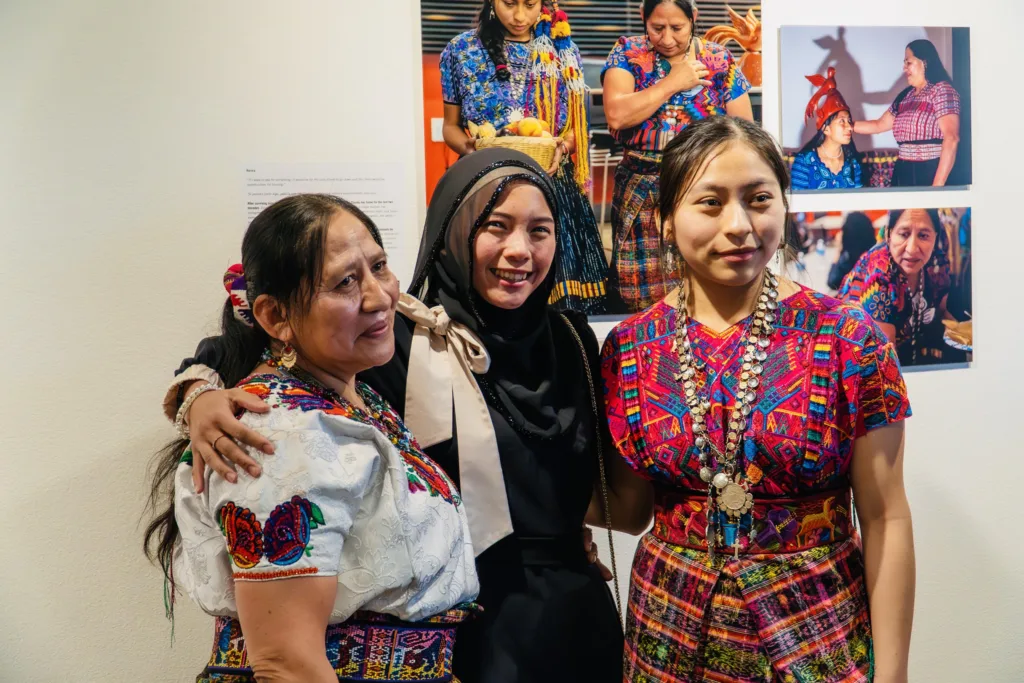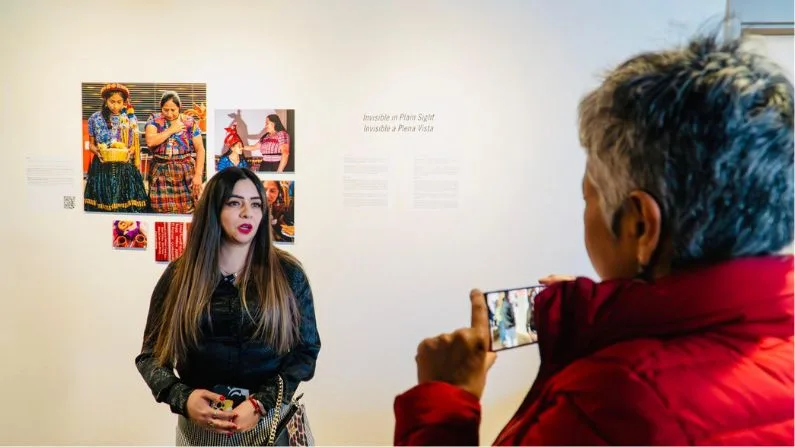A new exhibit at the Center for the Arts focuses on the immigrant experience. Titled “Invisible in Plain Sight,” the exhibit from photographer Jessyca Valdez features the portraits and stories of 14 immigrants from around the world currently living in Jackson Hole.
Valdez moved to Jackson in 2017 and soon after started taking photos of the region and of her young son. Like many, she came for economic opportunities — but discovered a new passion and career.
KHOL spoke with Valdez about her journey to photojournalism. A translated transcription of the interview is below.
Se puede leer la transcripción abajo.
EMILY COHEN/KHOL: How did you get into photography?
JESSYCA VALDEZ: When I arrived here, I couldn’t believe what a beautiful place I was living in. I thought it was like a postcard. And my son was growing up. So I wanted to have memories of the place where we were living.
KHOL: Can you talk about the transition from photographing your family to photojournalism?
VALDEZ: Well, I started taking pictures of myself, my family, my son and then people began to see a little bit of the work we were doing and they started hiring us for different events — quinceaneras, baptisms, family photos.
When I wanted to do photojournalism, it was because I wanted to be able to give back to the community a little of everything I had received and to be able to demonstrate how Latinos are capable of doing many things. I focused on this because in Mexico people think that we earn money very easily and they don’t see all the work that goes into earning a dollar.
Voices JH gave me the opportunity to work with them as a mobilizer, and I started listening. Our mission is to help Latinos [and other immigrants] get help. Then people gave me a chance to hear their stories. I wanted to take their stories so they could see how strong we are, how resilient we are to change culture, adapt to [a new] language. And I wanted to show a little bit of that. That’s why I got into photojournalism.
KHOL: How has becoming a photographer changed you?
VALDEZ: It has made me have more empathy for things that before I didn’t think had value. And it has completely turned my life around because it has opened my mind. Sometimes you think that your story is kind of difficult and when I heard all the stories of all the people who participated, I realized that my challenges are very small and that there is no comparison of my story with all the others I have heard.
KHOL: What do you want people to take away from this exhibition?
VALDEZ: I would like to highlight cultural diversity. And this community’s stories of resilience. I seek to promote understanding, empathy, equality and reveal the wealth and contributions that Latinos have brought to society.
KHOL: How did you gain the trust of your subjects?
VALDEZ: Well, I want to thank everyone for allowing me to be a part of their private space. It was a connection more than anything else, how they felt trust with me. It just happened. It was care shared between both parties. And trust.
Invisible in Plain Sight can be seen at the Center for the Arts through April 30. On April 26, the public can hear from the immigrant families who participated in the exhibit as they share their experiences living in Teton County. The event will include the premiere of the Invisible in Plain Sight film, and a bilingual panel discussion with participants.
***

Participants from the “Invisible In Plain Sight” photo exhibit pose at the opening event. (Photo courtesy of Emmanuel Estrada.)
COHEN/KHOL: ¿Cómo te metiste en la fotografía?
VALDEZ: Cuando yo llegué aquí, no podría creer el lugar tan hermoso en el que estaba viviendo. Pensé que era como una postal. Y mi hijo estaba creciendo. Entonces quería tener recuerdos del lugar donde estábamos viviendo. Pienso que las fotografías son como un momento para recordar.
KHOL: ¿Puedes hablar sobre la transición de fotografíar a tu familia, al fotoperiodismo?
VALDEZ: Bueno, empecé tomando fotografías hacia mi familia, mi hijo y después la gente empezó a ver como un poco el trabajo que estábamos haciendo y nos empezaron a contratar para diferentes eventos – quinceneras, bautizos, fotos personalizadas.
Cuando quise hacer el fotoperiodismo fue porque quise como devolver un poco a la comunidad del todo lo que yo había recibido y poder demostrar como los latinos somos capaces de hacer muchas cosas. Y me basé en eso porque en México la gente piensa que nosotros ganamos el dinero muy fácilmente y no ven como todo el trabajo que hay detrás de ganar un dólar. Aquí Voices JH me dio la oportunidad de trabajar con ellos como movilizadora y empecé a escuchar. Nuestra misión es ayudarlos a a las persona latina [y otros inmigrantes]. Y cómo ser un puente para para poder ayudarles. Entonces la gente me dio oportunidad de escuchar sus historias. Quise como tomar su sus historias para que vieran que tan fuertes somos, cuanta resiliencia tenemos porque cambiar cultura, adaptarnos a al idioma. Y quise mostrar un poco de eso. Es por eso que me metí a fotoperiodismo. ?
KHOL: ¿Cómo te ha cambiado convertirte en fotógrafa??
VALDEZ: Me ha hecho como tener más empatía por más cosas que antes pienso que no valoraba. Y ha dado un giro completamente a mi vida porque me ha abierto más mi mente. Porque. Porque si a veces tú piensas que tu historia es como un poco difícil y al escuchar todas las historias de todas las personas que que participaron, me di cuenta que. Que lo mío es muy chiquito y que no hay comparación de mi historia con todas las demás que he escuchado.
KHOL: ¿Qué es lo que quieres que la gente se lleve de esta exposición?
VALDEZ: Me gustaría resaltar la diversidad cultural. Y las historias de resiliencia de esta comunidad. Busco promover la empatía, la comprensión, La igualdad. Revelando la riqueza y contribuciones que los latinos hemos aportado a la sociedad.
KHOL: ¿Cómo te ganaste la confianza de tus sujetos?
VALDEZ: Bueno, quiero agradecerles por permitirme tener un espacio en su privacidad. No sé. Siento que fue una conexión más que otra cosa. Como sintieron en confianza conmigo. No podría darte una respuesta como tal porque solo se dio. Fue como un no sé, como cariño. Compartido entre ambas partes. Y confianza.
Se puede ver la exposición de fotos Invisible a Plena Vista en el Centro de Artes en Jackson hasta el 30 de abril. Hay una discusión el viernes 26 de abril.






